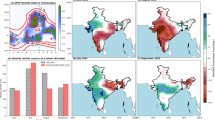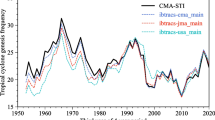Abstract
In the different development phases of a tropical cyclone, the most exciting and complex phase is its landfall, which is when a tropical cyclone moves over to the land after crossing the ocean’s coast. The location, time, and intensity at landfall of a tropical cyclone determine the extent of the disaster caused by it. In this work, we investigate a fundamental question: will a tropical cyclone make a landfall? Knowing the answer to this question with high accuracy will have huge benefits as the preparedness for a potential landfall involves mobilizing substantial human and economic resources. To answer this fundamental question, we have used high-resolution reanalysis data ERA5 (ECMWF reanalysis \(5^{th}\) generation) and best track data IBTrACS (International Best Track Archive for Climate Stewardship) to develop a deep learning model that can predict the landfall event in the early phase of a tropical cyclone—in particular, using any 12 hours or 24 hours of data from the first 72 hours of its inception with very high accuracy. We tested the model for six ocean basins of the world and achieved a fivefold accuracy in the range of \(97.6\%\) to \(99.2\%\) across all basins. The model can be trained within 05 to 20 minutes depending on the ocean basin and can predict the above-stated problem within seconds, making it suitable for real-time application.







Similar content being viewed by others
Code availability
The datasets used in this study are public. The code and required procedures to download the required dataset and reproduce the results are available at GitHUB—https://github.com/skashodhiya/Will-a-Tropical-Cyclone-Make-Landfall-
Abbreviations
- TCs:
-
Tropical cyclones
- NA:
-
North Atlantic
- NI:
-
North Indian
- SI:
-
South Indian
- WP:
-
West Pacific
- SP:
-
South Pacific
- EP:
-
East Pacific
- ANN:
-
Artificial neural network
- CNN:
-
Convolutional neural network
- RNN:
-
Recurrent neural network
- LSTM:
-
Long short-term memory networks
- IMD:
-
Indian Meteorological Department
- IBTrACS:
-
International Best Track Archive for Climate Stewardship
- ECMEF:
-
European Centre for Medium-range Weather Forecasts
- ERA5:
-
ECMWF reanalysis version-5
- FAR:
-
False alarm rate
- POD:
-
Probability of detection
- FPR:
-
False positive rate
- FNR:
-
False negative rate
- AUC:
-
Area under the curve
- ROC:
-
Receiver operating characteristics curve
References
Grinsted A, Ditlevsen P, Christensen JH (2019) Normalized us hurricane damage estimates using area of total destruction, 1900-2018. Proceedings of the National Academy of Sciences 116(48), 23942–23946 https://www.pnas.org/content/116/48/23942.full.pdf. https://doi.org/10.1073/pnas.1912277116
Webersik C, Esteban M, Shibayama T (2010) The economic impact of future increase in tropical cyclones in Japan. Natural Hazards 55:233–250. https://doi.org/10.1007/s11069-010-9522-9
Knutson T, Camargo SJ, Chan JCL, Emanuel K, Ho C-H, Kossin J, Mohapatra M, Satoh M, Sugi M, Walsh K, Wu L (2019) Tropical cyclones and climate change assessment: Part i: Detection and attribution. Bull Am Meteorol Soc 100(10):1987–2007. https://doi.org/10.1175/BAMS-D-18-0189.1
Leroux M-D, Wood K, Elsberry RL, Cayanan EO, Hendricks E, Kucas M, Otto P, Rogers R, Sampson B, Yu Z (2018) Recent advances in research and forecasting of tropical cyclone track, intensity, and structure at landfall. Tropical Cyclone Res Rev 7(2):85–105. https://doi.org/10.6057/2018TCRR02.02
Hall TM, Jewson S (2007) Statistical modeling of north atlantic tropical cyclone tracks. Tellus 59A:486–498. https://doi.org/10.1111/j.1600-0870.2007.00240.x
Gupta V, Mittal M, Mittal V, Chaturvedi Y (2022) Detection of r-peaks using fractional fourier transform and principal component analysis. J Ambient Intell Humanized Comput 13(2):961–972
Mia M, Roy S, Das SK, Rahman M et al (2020) Mango leaf disease recognition using neural network and support vector machine. Iran J Computer Sci 3(3):185–193
Akman M, Uçar MK, Uçar Z, Uçar K, Baraklı B, Bozkurt MR (2022) Determination of body fat percentage by gender based with photoplethysmography signal using machine learning algorithm. IRBM 43(3):169–186. https://doi.org/10.1016/j.irbm.2020.12.003
Chen R, Wang X, Zhang W, Zhu X, Li A, Yang C (2019) A hybrid cnn-lstm model for typhoon formation forecasting. Geoinformatica 23(3):375–396. https://doi.org/10.1007/s10707-019-00355-0
Moradi Kordmahalleh M, Gorji Sefidmazgi M, Homaifar A (2016) A sparse recurrent neural network for trajectory prediction of atlantic hurricanes. GECCO ’16, pp. 957–964. Association for Computing Machinery, New York, NY, USA. https://doi.org/10.1145/2908812.2908834
Chaudhuri S, Basu D, Das D, Goswami S, Varshney S (2017) Swarm intelligence and neural nets in forecasting the maximum sustained wind speed along the track of tropical cyclones over bay of bengal. Natural Hazards. https://doi.org/10.1007/s11069-017-2824-4
Giffard-Roisin S, Yang M, Charpiat G, Kumler Bonfanti C, Kégl B, Monteleoni C (2020) Tropical cyclone track forecasting using fused deep learning from aligned reanalysis data. Front Big Data 3:1. https://doi.org/10.3389/fdata.2020.00001
Boussioux L, Zeng C, Guénais T, Bertsimas D (2020) Hurricane forecasting: A novel multimodal machine learning framework. http://arxiv.org/abs/2011.06125
Alemany S, Beltran J, Perez A, Ganzfried S (2018) Predicting hurricane trajectories using a recurrent neural network. Proceedings of the AAAI Conference on Artificial Intelligence 33. https://doi.org/10.1609/aaai.v33i01.3301468
Gao S, Zhao P, Pan B, Li Y, Zhou M, Xu J, Zhong S, Shi Z (2018) A nowcasting model for the prediction of typhoon tracks based on a long short term memory neural network. Acta Oceanologica Sinica 37:8–12. https://doi.org/10.1007/s13131-018-1219-z
Kim S, Kim H, Lee J, Yoon S, Kahou SE, Kashinath K, Prabhat M (2019) Deep-hurricane-tracker: Tracking and forecasting extreme climate events, pp. 1761–1769. https://doi.org/10.1109/WACV.2019.00192
Kumar S, Biswas K, Pandey AK (2021) Track prediction of tropical cyclones using long short-term memory network. In: 2021 IEEE 11th Annual Computing and Communication Workshop and Conference (CCWC), pp. 0251–0257. https://doi.org/10.1109/CCWC51732.2021.9376027
Pradhan R, Aygun RS, Maskey M, Ramachandran R, Cecil DJ (2018) Tropical cyclone intensity estimation using a deep convolutional neural network. IEEE Trans Image Process 27(2):692–702. https://doi.org/10.1109/TIP.2017.2766358
Chen B-F, Chen B, Lin H-T, Elsberry RL (2019) Estimating tropical cyclone intensity by satellite imagery utilizing convolutional neural networks. Weather Forecast 34(2):447–465. https://doi.org/10.1175/WAF-D-18-0136.1
Maskey M, Ramachandran R, Ramasubramanian M, Gurung I, Freitag B, Kaulfus A, Bollinger D, Cecil DJ, Miller J (2020) Deepti: Deep-learning-based tropical cyclone intensity estimation system. IEEE J Selected Topics Appl Earth Observ Remote Sens 13:4271–4281. https://doi.org/10.1109/JSTARS.2020.3011907
Shakya S, Kumar S, Goswami M (2020) Deep learning algorithm for satellite imaging based cyclone detection. IEEE J Selected Topics Appl Earth Observ Remote Sens 13:827–839. https://doi.org/10.1109/JSTARS.2020.2970253
Berrisford P, Coauthors (2011) The era-interim archive version 2.0 (1), 23
Vitart F, Anderson D, Stockdale T (2003) Seasonal forecasting of tropical cyclone landfall over mozambique. J Clim 16(23):3932–3945
Wahiduzzaman M, Oliver EC, Wotherspoon SJ, Holbrook NJ (2017) A climatological model of north indian ocean tropical cyclone genesis, tracks and landfall. Clim Dyn 49(7):2585–2603
Mohapatra M, Nayak D, Sharma M, Sharma R, Bandyopadhyay B (2015) Evaluation of official tropical cyclone landfall forecast issued by india meteorological department. Journal of Earth System Science 124. https://doi.org/10.1007/s12040-015-0581-x
Powell MD, Aberson SD (2001) Accuracy of united states tropical cyclone landfall forecasts in the atlantic basin (1976–2000). Bull Am Meteorol Soc 82(12):2749–2768. https://doi.org/10.1175/1520-0477(2001)082<2749:AOUSTC>2.3.CO;2
Kumar S, Biswas K, Pandey AK (2021) Prediction of landfall intensity, location, and time of a tropical cyclone. In: Proceedings of the AAAI Conference on Artificial Intelligence, vol. 35, pp. 14831–14839
Kumar S, Biswas K, Pandey AK (2021) Predicting landfall’s location and time of a tropical cyclone using reanalysis data. http://arxiv.org/abs/2103.16108
Knapp KR, Kruk MC, Levinson DH, Diamond HJ, Neumann CJ (2010) The international best track archive for climate stewardship (ibtracs): Unifying tropical cyclone data. Bull Am Meteorol Soc 91(3):363–376. https://doi.org/10.1175/2009BAMS2755.1
Hersbach H, Bell B, Berrisford P, Hirahara S, Horányi A, Muñoz-Sabater J, Nicolas J, Peubey C, Radu R, Schepers D, Simmons A, Soci C, Abdalla S, Abellan X, Balsamo G, Bechtold P, Biavati G, Bidlot J, Bonavita M, De Chiara G, Dahlgren P, Dee D, Diamantakis M, Dragani R, Flemming J, Forbes R, Fuentes M, Geer A, Haimberger L, Healy S, Hogan RJ, Hólm E, Janisková M, Keeley S, Laloyaux P, Lopez P, Lupu C, Radnoti G, de Rosnay P, Rozum I, Vamborg F, Villaume S, Thépaut J-N (2020) The era5 global reanalysis. Quarterly Journal of the Royal Meteorological Society 146(730), 1999–2049 https://rmets.onlinelibrary.wiley.com/doi/pdf/10.1002/qj.3803. https://doi.org/10.1002/qj.3803
McCulloch WS, Pitts W (1943) A logical calculus of the ideas immanent in nervous activity. Bull Math Biophys 5(4):115–133
Kiefer J, Wolfowitz J (1952) Stochastic estimation of the maximum of a regression function. Ann Math Statist 23(3):462–466. https://doi.org/10.1214/aoms/1177729392
Jordan MI (1990) Attractor Dynamics and Parallelism in a Connectionist Sequential Machine, pp. 112–127. IEEE Press, ???
Cleeremans A, Servan-Schreiber D, McClelland JL (1989) Finite state automata and simple recurrent networks. Neural Comput 1(3):372–381. https://doi.org/10.1162/neco.1989.1.3.372
Pearlmutter (1989) Learning state space trajectories in recurrent neural networks. In: International 1989 Joint Conference on Neural Networks, pp. 365–3722
Hochreiter S, Schmidhuber J (1997) Long short-term memory. Neural Comput 9(8):1735–1780. https://doi.org/10.1162/neco.1997.9.8.1735
Gers FA, Schmidhuber J, Cummins F (1999) Learning to forget: continual prediction with lstm. In: 1999 Ninth International Conference on Artificial Neural Networks ICANN 99. (Conf. Publ. No. 470), vol. 2, pp. 850–8552
Gers FA, Schraudolph NN, Schmidhuber J (2003) Learning precise timing with lstm recurrent networks. J Mach Learn Res 3:115–143. https://doi.org/10.1162/153244303768966139
Gers FA, Schmidhuber E (2001) Lstm recurrent networks learn simple context-free and context-sensitive languages. IEEE Trans Neural Netw 12(6):1333–1340
LeCun Y, Boser B, Denker JS, Henderson D, Howard RE, Hubbard W, Jackel LD (1989) Backpropagation applied to handwritten zip code recognition. Neural Comput 1(4):541–551. https://doi.org/10.1162/neco.1989.1.4.541
Krizhevsky A, Sutskever I, Hinton G (2012) Imagenet classification with deep convolutional neural networks. Neural Inf Process Syst 25:87. https://doi.org/10.1145/3065386
Milletari F, Navab N, Ahmadi S (2016) V-net: Fully convolutional neural networks for volumetric medical image segmentation. In: 2016 Fourth International Conference on 3D Vision (3DV), pp. 565–571. https://doi.org/10.1109/3DV.2016.79
Ioffe S, Szegedy C (2015) Batch normalization: Accelerating deep network training by reducing internal covariate shift. In: International Conference on Machine Learning, pp. 448–456. PMLR
Ciresan DC, Meier U, Masci J, Gambardella LM, Schmidhuber J (2011) Flexible, high performance convolutional neural networks for image classification. In: Twenty-second International Joint Conference on Artificial Intelligence
Chollet F (2015) Keras. GitHub
Nair V, Hinton GE (2010) Rectified linear units improve restricted boltzmann machines. In: Fürnkranz, J., Joachims, T. (eds.) Proceedings of the 27th International Conference on Machine Learning (ICML-10), June 21-24, 2010, Haifa, Israel, pp. 807–814. Omnipress, ???. https://icml.cc/Conferences/2010/papers/432.pdf
Han J, Moraga C (1995) The influence of the sigmoid function parameters on the speed of backpropagation learning. In: Mira J, Sandoval F (eds) From natural to artificial neural computation. Springer, Berlin, Heidelberg
Abadi M, Agarwal A, Barham P, Brevdo E, Chen Z, Citro C, Corrado GS, Davis A, Dean J, Devin M, Ghemawat S, Goodfellow I, Harp A, Irving G, Isard M, Jia Y, Jozefowicz R, Kaiser L, Kudlur M, Levenberg J, Mané D, Monga R, Moore S, Murray D, Olah C, Schuster M, Shlens J, Steiner B, Sutskever I, Talwar K, Tucker P, Vanhoucke V, Vasudevan V, Viégas F, Vinyals O, Warden P, Wattenberg M, Wicke M, Yu Y, Zheng X (2015) TensorFlow: Large-Scale Machine Learning on Heterogeneous Systems. Software available from tensorflow.org. https://www.tensorflow.org/
Pedregosa F, Varoquaux G, Gramfort A, Michel V, Thirion B, Grisel O, Blondel M, Prettenhofer P, Weiss R, Dubourg V, Vanderplas J, Passos A, Cournapeau D, Brucher M, Perrot M, Duchesnay E (2011) Scikit-learn: machine learning in Python. J Mach Learn Res 12:2825–2830
Kingma D, Ba J (2014) Adam: A method for stochastic optimization. International Conference on Learning Representations
Barnes LR, Gruntfest EC, Hayden MH, Schultz DM, Benight C (2007) False alarms and close calls: a conceptual model of warning accuracy. Weather Forecast 22(5):1140–1147. https://doi.org/10.1175/WAF1031.1
Funding
Authors did not receive any funding to assist with the preparation of this manuscript.
Author information
Authors and Affiliations
Corresponding author
Ethics declarations
Conflict of interest
The authors declare that they have no conflict of interest.
Additional information
Publisher's Note
Springer Nature remains neutral with regard to jurisdictional claims in published maps and institutional affiliations.
Rights and permissions
Springer Nature or its licensor (e.g. a society or other partner) holds exclusive rights to this article under a publishing agreement with the author(s) or other rightsholder(s); author self-archiving of the accepted manuscript version of this article is solely governed by the terms of such publishing agreement and applicable law.
About this article
Cite this article
Kumar, S., Biswas, K. & Pandey, A.K. Will a tropical cyclone make landfall?. Neural Comput & Applic 35, 5807–5818 (2023). https://doi.org/10.1007/s00521-022-07996-7
Received:
Accepted:
Published:
Issue Date:
DOI: https://doi.org/10.1007/s00521-022-07996-7




